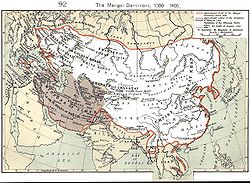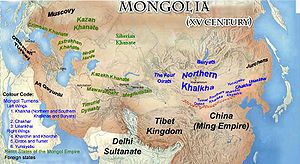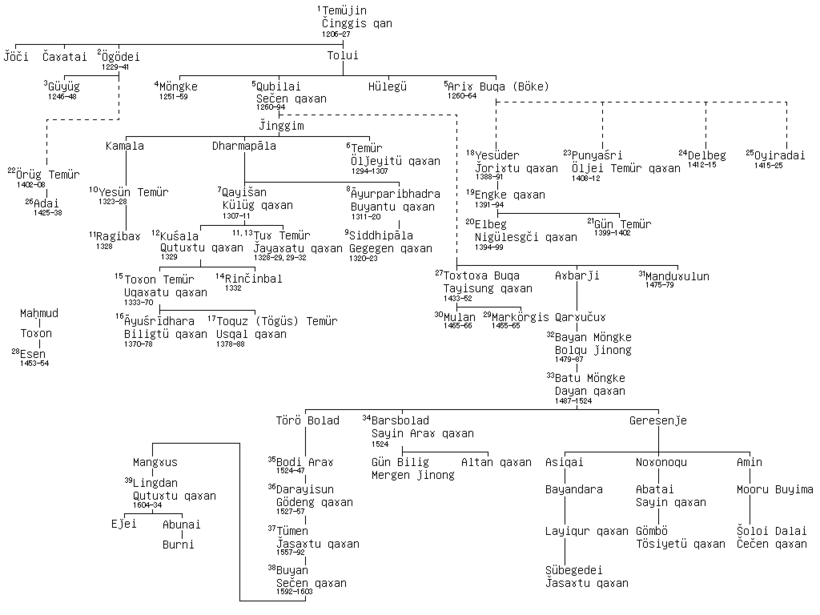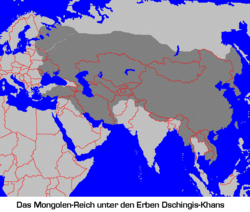- Borjigin
-
"Altan urag" redirects here. For the folk rock band, see Altan Urag.
Borjigin
БоржигинCountry Mongolia Titles Khagan, Khan Founder Bodonchar Munkhag Final sovereign Ligden Khan Current head Unknown Founding ca. 900 AD Deposition 1635-20th century Cadet branches Before Genghis Khan: Khiyan, Tayichigud, Jurkhin; after Genghis Khan: Khiyad-Borjigin, Jochids, Khorchin-Borjigins, Girays, Sheybanids, Khoshut Borjigin (plural Borjigid; Mongolian: Боржигин, Borjigin; Russian: Борджигин, Bordžigin; simplified Chinese: 博尔济吉特; traditional Chinese: 博爾濟吉特; pinyin: Bó'ěrjìjítè), also known as the Altan urug (Mongolian: Алтан ураг, Altan urag, Golden kin), were the imperial clan of Genghis Khan and his successors.
The Mongolian Borjigin clan is the most renowned family in Inner Asia. The senior Borjigids provided ruling princes for Mongolia and Inner Mongolia until the 20th century.[1] The clan formed the ruling class among the Mongols, Kazakhs, and other peoples of Inner Asia. Today, the Borjigid are found throughout most of Mongolia, parts of Inner Mongolia and Xinjiang.[1] Also there are many living in Kazakhstan as Tore, "AkSuyek", or "White Bone".
Origin
See also: Family tree of Genghis KhanThe patrilineage began with Blu-grey Wolf (Borte Chino) and Fallow Doe (Gua Maral). As in the Secret History of the Mongols, their 11th generation descendant Dobu Mergen's widow Alan Gua the Fair was impregnanted by a ray of light.[2] Her youngest son became the ancestor of the later Borjigid.[3] He was Bodonchar Munkhag (the Simple), who along with his brothers sired the entire Mongol nation.[4] According to Rashid-al-Din Hamadani, many of Mongolian old clans were founded by Borjigin members - Barulas, Urud, Manghud, Taichiut, Chonos, Kiyat etc. The first Khan of the Mongol was Bodonchar Munkhag's great-great-grandson Khaidu Khan. Khaidu's grandsons Khabul Khan and Ambaghai Khan (founder of the Taichiut clan) succeeded him. Thereafter, Qabul's sons, Hotula Khan and Yesugei, and great-grandson Temujin (Genghis Khan) ruled the Khamag Mongol. By the unification of the Mongols in 1206, virtually all of Temujin's uncles and first cousins died, and from then on only the descendants of Yesugei Baghatur formed the Borjigid.
Mongol Empire
See also: Appanage The Mongol Empire, ca. 1300. The gray area is the later Timurid empire.
The Mongol Empire, ca. 1300. The gray area is the later Timurid empire.
The Borjigin family ruled over the Mongol Empire from the 13th to 14th century. The rise of Genghis (Chingis) narrowed the scope of the Borjigid-Kiyad clans sharply.[5] This separation was emphasized by the intermarriage of Genghis's descendants with the Barulas, Baarin, Manghud and other branches of the original Borjigid. In the western regions of the Empire, the Jurkin and perhaps other lineages near to Genghis's lineage used the clan name Kiyad but did not share in the privileges of the Genghisids. The Borjigit clan had once dominated large lands stretching from Korea to Turkey and from Indo China to Novgorod. In 1335, with the disintegration of the Ilkhanate in Iran, the first of numerous non-Borjigid-Kiyad dynasties appeared. Established by marriage partners of Genghisids, these included the Suldus Chupanids, Jalayirids in the Middle East, the Barulas dynasties in Chagatai Khanate and India, the Manghud and Onggirat dynasties in the Golden Horde and Central Asia, and the Oirats in western Mongolia.
In 1368, under Toghun Temür, the Yuan Dynasty was overthrown by the Ming Dynasty in China but members of the family continued to rule over Mongolia into the 17th century, known as the Northern Yuan Dynasty. Descendants of Genghis Khan's brothers, Hasar and Belgutei, surrendered to the Ming in 1380's. By 1470 the Borjigin lines were severely weakened, and Mongolia was in almost chaos.
Post-Mongol Empire
After the breakup of the Golden Horde, the Khiyat continued to rule the Crimea and Kazan until the late 18th century. Another lineage of the Borjigin-Khiyat family ruled Kazakh Khanate and Moghulistan until 18th century. They were annexed by the Russian Empire and the Chinese. The Kazakh aristocracy traced back their lineage to Tuqa-Timur, a son of Jochi. In Mongolia, the Kublaids reigned as Khagan of the Mongols, however, descendants of Ogedei and Arikboke usurped the throne briefly.
Under Batumongke Dayan Khan (1480–1517) a broad Borjigid revival reestablished Borjigid supremacy among the Mongols proper. His descendants proliferated to become a new ruling class. The Borjigin clan was the strongest of the 49 Mongol banners. The eastern Horchins were under the Hasarids, and the Ongnigud, Abagha Mongols were under the Belguteids and Temuge Odchigenids. A fragment of the Hasarids deported to Western Mongolia became the Khoshuts.
The Qing Dynasty respected the Borjigin family and the early Emperors married the Hasarid Borjigids of the Horchin. Even among the pro-Qing Mongols, traces of the alternative tradition survived. Aci Lomi, a banner general, wrote his History of the Borjigid Clan from 1732-35.[6] The 18th century and 19th century Qing nobility was adorned by the descendants of the early Mongol adherents including the Borjigin.[7]
Genghisids
Main article: Descent from Genghis Khan Shokan Valikhanov (left) and Fyodor Dostoyevsky (right). Valikhanov was a Genghisid of the Jochi lineage.
Shokan Valikhanov (left) and Fyodor Dostoyevsky (right). Valikhanov was a Genghisid of the Jochi lineage.
Descent from Genghis Khan is traceable primarily in Central Asia. His four sons and other immediate descendants are famous by names and by deeds. Later Asian potentates attempted to claim such descent even with flimsy grounds. In the 14th century, valid sources (heavily dependent on Rashid-al-Din Hamadani and other Persian or Arabic historians) all but dry up. With the recent popularity of genealogical DNA testing, a wider circle of people started to claim descent from the great conqueror.
Among the Asian dynasties descended from Genghis Khan were the Yuan Dynasty of China, the Ilkhanids of Persia, the Jochids of the Golden Horde, the Shaybanids of Siberia, and the Astrakhanids of Central Asia. As a rule, the Genghisid descent was crucial in Tatar politics. For instance, Mamai had to exercise his authority through a succession of puppet khans but could not assume the title of khan himself because he was not of the Genghisid lineage.
The word "Chingisid" derives from the name of the Mongol conqueror Genghis (Chingis) Khan (c. 1162–1227 CE). Genghis and his successors created a vast empire stretching from the Sea of Japan to the Black Sea.
- The Chingisid principle,[8] or golden lineage, was the rule of inheritance laid down in the (Yassa), the legal code attributed to Genghis Khan.
- A Chingisid prince was one who could trace direct descent from Genghis Khan in the male line, and who could therefore claim high respect in the Mongol and Turkic world.
- The Chingisid states were the successor states or Khanates after the Mongol empire broke up following the death of the Genghis Khan's sons and their successors.
- The term Chingisid people was used to describe the people of Genghis Khan's armies who came in contact with Europeans, primarily the Golden Horde, led by Batu Khan, a grandson of Genghis. These were predominantly Oghuz — Turkic speaking people rather than Mongols. (Although the aristocracy was largely Mongol, Mongols were never more than a small minority in the armies and the lands they conquered.) Europeans often (incorrectly) called the people of the Golden Horde Tartars.
Babur and Humayun, founders of the Mughal Empire in India, asserted their authority as Chinggisids. Because they claimed it through their maternal lineage, they had never used the clan name - Borjigin.
The last ruling monarch, Mohammed Alim Khan (d.1944), of Genghisid ancestry was overthrown by Red Army in 1920.
Yuan Dynasty family tree in Mongolia
Genghis Khan founded the Mongol Empire in 1206. His grandson, Kublai Khan founded the Yuan Dynasty in China in 1271. The dynasty was overthrown by the Ming Dynasty during the reign of Toghaghan-Temür in 1368, but it survived in Mongolia, known as the Northern Yuan. Although the kingship was usurped by Esen Tayisi of the Oirats in 1453, he was overthrown in the next year. A recovery of the khaganate was achieved by Batumongke Dayan Khan, but the territory was segmented by his descendants. The last khaan Ligden died in 1634 and his son Ejei Khongghor submitted himself to Hong Taiji the next year, ending the Northern Yuan regime.[9] However, the Borjigin nobles continued to rule their subjects until the 20th century under the Qing.[10]
Wada Sei did pioneer work on this field, and Honda Minobu and Okada Hidehiro modified it, utilizing newly discovered Persian (Timurid) records and Mongol chronicles.
Yuan Emperors in China and Mongolia
The following is the Yuan dynasty family tree.
Genghis Khan founded the Mongol Empire in 1206. The empire became split beginning with the succession war of his grandsons Kublai Khan and Ariq Boke. Kublai Khan, after defeating his younger brother Ariq Boke, founded the Yuan Dynasty in China in 1271. The dynasty was overthrown by the Ming Dynasty during the reign of Toghun Temür in 1368, but it survived in Mongolia, known as the Northern Yuan Dynasty; years of reign over the Northern Yuan Dynasty are given in brackets.
YUANEMPS YUANEMPS YUANEMPS YUANEMPS YUANEMPS YUANEMPS Yesükhei Baghatur 1 2 3 (1) 4 (2) 5 (3) 6 (4) Belgutei Bekhter Temujin
Genghis Khan
~1162-1227
Taizu 太祖
Khagan 1206-27Hasar Hachiun Temüge 1 2 3 4 Jochi
d.1227Chagatai
d.1241Ögedei Khan
~1186-1241
Taizong 太宗
Khagan 1229-41Tolui
~1190-1232
Ruizong 睿宗
(Khagan 1227-29)1 1 2 3 4 Güyük Khan
~1206-1248
Dingzong 定宗
Khagan 1246-48Möngke Khan
~1208-1259
Xianzong 憲宗
Khagan 1251-59Kublai Khan
1215-1294
Khagan 1260-71
Shizu 世祖
1271-1294Hulagu
~1217-1265
Ilkhan 1256-65Ariq Böke
d.1266
Khagan 1260?2 Zhenjin 真金
1243-1285
Yuzong 裕宗1 2 3 Kamala
d.1302
Xianzong 显宗Darmabala
Shunzong 顺宗Temür
Öljeytü Khan
1265-1307
Chengzong 成宗
1294-13071 1 2 Yesün Temür Khan
1293-1328
Taiding 泰定
1323-1328Kayishan
Külüg Khan
1281-1311
Wuzong 武宗
1308-1311Ayurbarwada
Buyantu Khan
1286-1320
Renzong 仁宗
1311-13201 1 2 1 Ragibagh Khan
~1320-1328?
Tianshun 天順
1328Kuśala
Khutughtu Khan
1300-1329
Mingzong 明宗
1329Tugh Temür
Jayaatu Khan
1304-1332
Wenzong 文宗
1328-29, 1329-32Shidibala
Gegeen Khan
1303-1323
Yingzong 英宗
1321-13231 2 Toghun Temür Ukhaantu Khan
1320-1370
Huizong 惠宗
1333-68 ( -1370)Rinchinbal Khan
1326-1332
Ningzong 寧宗
1332Ayushiridara
Biligtü Khan
Zhaozong 昭宗
(1370-1378)Tögüs Temür
Uskhal Khan
Yizong 益宗
(1378-1388)Modern relevance
 Navaanneren, Minister of the Interior, who along with the 23rd Tushiyetu Khan Dorjsurenkhoroljav (1908-1937) was the last of the Borjigin with the title of Khan in Mongolia. He was executed during the great purges of 1937.
Navaanneren, Minister of the Interior, who along with the 23rd Tushiyetu Khan Dorjsurenkhoroljav (1908-1937) was the last of the Borjigin with the title of Khan in Mongolia. He was executed during the great purges of 1937.
The Borjigin lost power when Communists took control. Aristocratic descent was something to be forgotten in the socialist period.[11] Joseph Stalin's henchmen executed some 30,000 Mongols including Borjigin nobles in a series of campaigns against their culture and religion.[12] Clan association has lost its practical relevance in the 20th century, but is still considered a matter of honour and pride by many Mongolians. In 1920s the communist regime banned the use of clan names. When the ban was lifted again in 1997, most families had lost knowledge about their clan association. Because of that, a disproportionate number of families registered the most prestigious clan name Borjigin, many of them without historic justification.[13] The label Borjigin is used as a measure of cultural supremacy.[14]
In Inner Mongolia, the Borjigid or Kiyad name became the basis for many Chinese surnames.[5] The Inner Mongolian Borjigin Taijis took the surname Bao (from Borjigid) and in Ordos Qi (Qiyat). Recent genetic research has confirmed that as many as 16 million men from Manchuria to Afghanistan may have Borjigid-Kiyad ancestry.[15] The Qiyat clan name is still found among the Kazakhs, Uzbeks and Karakalpaks.
List of Kiyad-Borjigin dynasties
- Mongol Empire:
- Golden Horde
- Kazan Khanate
- Shaibanid
- Uzbek Khanate
- Kazakh Khanate
- Manghit Dynasty
- Khanate of Khiva
- Khanate of Bukhara
- Uzbek Khanate
- Giray Dynasty
- Astrakhan Khanate
- Chagatai Khanate
- Yuan Dynasty
- Ilkhanate
- Golden Horde
Prominent Kiyads or Borjigins
The Mongol Empire and its client states, c. 1311.
Rulers of the Khamag Mongol (11th century-1206)
- Khaidu
- Khabul Khan
- Yesugei
Emperors and rulers of the Mongol Empire (1206–1368)
Genghis Khan's brothers
Rulers of the Khanates
Yuan Dynasty
- Kublai Khan
- Temür Khan
- Toghan Temur Khan
Golden Horde
Ilkhanate
- Hulegu
- Abaqa
- Ghazan
Chagatai Khanate
Post-Mongol Empire Golden Horde (1360–1502)
Crimean Khanate (1441–1783)
- Mengli Giray
Kazan Khanate (1438–1552)
- Olug Moxammat
Uzbek Khanates (15th - mid 20th century)
- Muhammad Shaybani
- Abulghazi Bahadur
- Mohammed Alim Khan
Kazakh Khanate (1456–1731)
Northern Yuan Dynasty (1368–1635)
- Öljei Temür Khan
- Batumongke Dayan Khan
- Ligden Khan
Ruler of the Tumed
Khalkha
Empress of the Qing Dynasty (1636–1717)
- Empress Dowager Xiaozhuang
- Empress Xiaohuizhang
Gallery
-
Tolui with his wife Sorghaghtani Beki
-
Mengli Giray at the court of Bayezid II
See also
- Mongol Empire
- Family tree of Genghis Khan
- List of Mongol Khans
- Tatar
- Mongolian name
- List of medieval Mongolian tribes and clans
- Jüz
- History of Mongolia
- Khalkha
- Turco-Mongol
- List of family trees
References
- Wada Sei 和田清. Tōashi Kenkyū (Mōko Hen) 東亜史研究 (蒙古編). Tokyo, 1959.
- Honda Minobu 本田實信. On the genealogy of the early Northern Yüan, Ural-Altaische Jahrbücher, XXX-314, 1958.
- Okada Hidehiro 岡田英弘. Dayan Hagan no nendai ダヤン・ハガンの年代. Tōyō Gakuhō, Vol. 48, No. 3 pp. 1–26 and No. 4 pp. 40–61, 1965.
- Okada Hidehiro 岡田英弘. Dayan Hagan no sensei ダヤン・ハガンの先世. Shigaku Zasshi. Vol. 75, No. 5, pp. 1–38, 1966.
Notes
- ^ a b Caroline Humphrey, David Sneath-The end of Nomadism?, p.27
- ^ The Secret History of the Mongols , Ch.1 $17
- ^ Herbert Franke, Denis Twitchett, John King Fairbank - The Cambridge History of China: Alien regimes and border states, 907-1368 , p.330
- ^ Kahn, Paul. The Secret History of the Mongols, p. 10.
- ^ a b C.P.Atwood-Encyclopedia of Mongolia and the Mongol Empire, p.45
- ^ Peter C. Perdue-China marches west, p.487
- ^ Pamela Kyle Crossley-A Translucent Mirror, p.213
- ^ Russia and the Golden Horde: The Mongol Impact on Medieval Russian History (Chapter VIII) By Charles J. Halperin, Published by Indiana University Press, 1985 ISBN 0253204453, ISBN 9780253204455
- ^ Ann Heirman, Stephan Peter Bumbacher-The spread of Buddhism, p.395
- ^ David Sneath-Changing Inner Mongolia: pastoral Mongolian society and the Chinese state, p.21
- ^ Caroline Humphrey, David Sneath-The end of Nomadism?, p.28
- ^ Jack Weatherford-Genghis Khan, p.XV
- ^ "In Search of Sacred Names", Mongolia Today, http://www.mongoliatoday.com/issue/5/names.html
- ^ Carole Pegg-Mongolian music, dance, & oral narrative, p.22
- ^ Genetic legacy of the Mongols, American journal of Human genetics 72. p. 717-721
- ^ According to H.H.Howorth, Mamai used the clan name Kiyad which is near to Genghisid lineage. However, he was not direct descendant of Genghis Khan, The History of the Mongols, part.II, D.II, p.190
— Royal house —House of BorjiginPreceded by
Liao DynastyRuling House of Mongolia
11th century–1635Great Khan's seat in Chahar was conquered by the Aisin Gioro New title Ruling House of the Mongol Empire
1206–1368Northern Yuan Dynasty
the Empire collapsedPreceded by
Song DynastyRuling House of China
1271–1368Protector of Tibet
1271-1368Preceded by
Khwārazm-Shāh dynastyRuling House of Persian Empire
1247–1335Succeeded by
Jalayirids
Chupanid SuldusPreceded by
The Khanate establishedRuling House of the Golden Horde
1236–1502Succeeded by
Kiyat Girays
TatarsFamily trees Monarchies of Africa Ethiopian emperors
Monarchies of the Americas Monarchies of Asia Chinese: (Ancient China · Early China · Middle China · Late China) · Japan · Korean: (Goryeo · Joseon) · Mongolian: (Yuan · Ilkhanate · Timurid) · Vietnam · Indian: Mughal
Monarchies of Europe Aragon · Belgium · Bosnia · Denmark · England (simplified) · Wessex · Mercia · East Anglia · United Kingdom after 1603 · France (simplified) · House of Bonaparte · Greece · Netherlands · Norway · Portugal · Eastern Roman/Byzantine Emperors · Holy Roman Empire/Germany · House of Habsburg (incl. Holy Roman Empire after 1440) · Russia · Scotland · Serbia · Sicily · Spain · Navarre · Sweden (partial) ·
Monarchies of the Middle East Persian dynasties: (Pre-Islamic:Achaemenid · Arsacid · Sassanid -post-Islamic:Tahirid · Alavid · Saffarid · Samanid · Ziyarid · Buyid · Ghaznavids · Khwarazm · Chupanid · Muzaffarid · Jalayirid -Modern:Safavid · Afsharid · Zand · Qajar) · Jerusalem · Ottoman (simplified) · House of Muhammad Ali · Kuwait
Monarchies of Oceania Bora Bora · Hawaii: (Kamehameha · Lunalilo · Kalākaua · Kawānanakoa · Kalokuokamaile) · Huahine · Tahiti · Tonga
Dukedoms, princes and counts Monarchies of the ancient world Egyptian dynasties: (4th · 12th · 18th · 19th · 20th · 21st · 25th · 26th · Ptolemies) · Attalid · Seleucids · Roman Emperors · Caecilii Metelli · Scipio-Paullus-Gracchus · Julio-Claudian dynasty · Severan dynasty · Constantinian dynasty
Mongol ethnic groups In Mongolia Barga · Bayid · Buryat · Selenge Chahar · Darkhad · Dariganga · Dörbet · Myangad · Khalkha · Hotogoid · Hoton · Ööled · Sartuul · Torgut · Tuva Uriankhai · Uriankhai · Altai Uriankhai · Üzemchin · ZakhchinIn China (HL, JL, LN, NM, XJ) In China (not mentioned above) In Russia In Kyrgyzstan Sart KalmykElsewhere in Central Asia Categories:- Mongolian nobility
- Borjigin
- People of the Mongol Empire
- Mongol peoples
- Mughal emperors
- Yuan Dynasty emperors
- Genghis Khan
- Mongol Empire
- Yuan Dynasty
- Ethnic groups in Mongolia
- History of Mongolia
- Kinship and descent
- Dynasty genealogy
- Royalty
- Royal families
Wikimedia Foundation. 2010.










